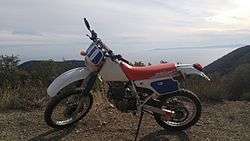Honda XR250R and XR250L
|
A 1994 Honda XR250R | |
| Manufacturer | Honda |
|---|---|
| Production | 1979–2004 |
| Predecessor | Honda XL250 |
| Successor | Honda CRF |
| Class | Off road and Dual-sport |
| Engine | Single-cylinder, SOHC, 4-valve, oil-cooled, four-stroke |
| Bore / stroke | (86-95) 73 mm × 59.5 mm (2.87 in × 2.34 in)[1] |
| Compression ratio | (86-95) 10.2:1[1] |
| Power | (86-95) 24.56 hp (18.31 kW)@ 8,000 rpm (claimed)[1] |
| Torque | (86-95) 16.85 ft/lb (11.32 m/kg)@7, rpm (claimed)[1] |
| Transmission | 6-speed[2] |
| Suspension |
Front: (90-95) 41mm cartridge forks with 11 in (280 mm) of travel[1] |
| Brakes |
Front: 240mm Disc[2] Rear: (79-89) Drum [3] Rear: (90-04) 220mm Disc[2][3] |
| Tires |
Front: 80/100-21[2] Rear: 100/100-18[2] |
| Rake, trail |
(85-95) 25°, 100 mm (3.9 in) (96-04) 24°, 92 mm (3.6 in) |
| Wheelbase |
|
| Dimensions |
L:
|
| Seat height |
|
| Weight |
(dry) |
| Fuel capacity | (86-95) 9.0 l; 1.98 imp gal (2.38 US gal) 2.6 US gal (9.8 l; 2.2 imp gal) |
| Oil capacity | (86-95) 1,600 ml (1.7 US qt) |
The Honda XR250R and XR250L are trail and dual-sport motorcycles made by Honda from 1979 through 2004, as part of the Honda XR series. They have four-stroke, SOHC four-valve 249 cc (15.2 cu in) Single-cylinder engines.
In 1981, the XR250 got a single rear shock.[4] In 1984, the bike was introduced with Honda's Radial Four Valve Combustion Chamber (RFVC). It has a 110 kg (240 lb) claimed dry weight,[1] and a 36-inch seat height (96-04). Honda said the engine produces 19.6 peak hp and 14-15 lb feet of torque.[1] The 1996-2004 versions of the XR250R had 10.6 inches of suspension travel front and rear and 41mm front cartridge forks. The tire size was 80/100-21 front and 100/100-18 rear. It had 13-48 tooth gearing and a stock top speed of around 66 mph at 8000 rpm. The XR250L was a heavier, street-legal version. Between 1979 and 1981, the XR250 had a 23 inch front wheel[4]
Unlike the CRF230F, which effectively replaced the XR200R in Honda's lineup as an air cooled off road motorcycle, the XR250R has no air cooled predecessor, but was replaced by the CRF250X.
The engines in both the off-road-only XR250R and street-legal XL250L are identical. In the United States the L has a 3 mm smaller header pipe and a different carburetor to satisfy emissions regulations, though both carburetors have a 30 mm throttle body. The engine has a four-valve head with splayed rocker arms to actuate the valves. Unusual for a single-cylinder engine, it has a two-into-one header pipe. Throughout its production, The R version is kickstart only, features a six-speed transmissions with chain final drive, and has stator ignition. For the pre-1996 models, the suspension travel was 260 mm (10 in) front and rear. The XR250R is the enduro (competition) model; however, the L version is electric start, with pillion pegs, softer suspension and lower seat height. The changes between 1996 and 2004 consisted of decal updates, the mechanical parts being identical. The XR250R was discontinued after 2004.
| 1981 | Single rear shock[4] |
| 1984 | Radial Four-Valve Combustion Chamber (RFVC). 75mm bore × 56.5mm stroke |
| 1986 | Single carburetor. Engine saw a smaller bore & longer stroke. 73mm bore × 59.5mm stroke. |
| 1990 | Rear disc brake and cartridge forks[3] |
| 1996 | Revised suspension with 10.6 in (270 mm) of travel and a steeper steering angle. Updated dry-sump engine with lighter flywheel and counterweight now produces 19 hp. New engine mounts, exhaust valves, revised decompression system for easier starting |
References
- 1 2 3 4 5 6 7 8 9 10 11 Honda 1986-1995 Service Manual. November 1993.
- 1 2 3 4 5 "Living With Honda's XR250R". Motorcycle.com. April 1996. Retrieved 2016-10-08.
- 1 2 3 "1986-2005 HONDA XR250R - DIRT RIDER MAGAZINE". Dirt Rider Magazine. Sep 2009. Retrieved 2016-10-08.
- 1 2 3 "The Amazing History Of Honda Dirt Bikes!". Honda-Elsinore.com. 2002. Retrieved 2016-10-08.
External links
- "Two For the Trail", Cycle World, pp. 50–54, January 1986
